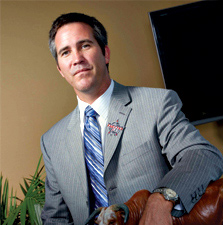Bernard to reveal 5-year IndyCar strategic plan
 |
| Randy Bernard working on 5-year IndyCar strategic Plan |
IndyCar CEO Randy Bernard stops mid-sentence. He glances at the ceiling in the hotel conference room where he has been ensconced for most of the day.
"I actually don't know how the crowd is out there," he says. "How is the crowd out there?"
Saturday in Baltimore he met with members of his leadership team and possible sponsors and sought feedback from race team members. He's at work, he says, on a long-term plan for the sport. He hopes to reveal it in about a month.
"One thing I've learned is that I've got to put blinders on a little bit, to block out some of the stuff going on day-by-day," he said. "We need to take a look and make decisions not just based on today, but a few years down the road."
Bernard has been impressed with the show in Baltimore so far, and said the race has the "potential to become a fixture." But he needs to make sure that the organizing group, Race On, does a better job than the team that ran last year's race. That group's inability to pay its bills fed into the perception that IndyCar is instable.
Bernard has consistently said that he's watching this year's group closely. They paid their fees to IndyCar on time, Bernard said, and there have been no complaints filed from unpaid vendors.
"They've just got to prove that their economic impact on the city is positive," Bernard said.
Though neither race organizers nor Baltimore police will offer an attendance estimate, most agree the crowds have been thinner this year than they were last year. That's not totally unexpected; Race On general manager Tim Mayer has said they're not concerned with crowd size, and Bernard said he expected a "sophomore slump."
"The organization for this event has been really good," he said. "They're engaged in the process, they're invested. That's important for down the line. They've got to build momentum."
Bernard was chosen two years ago to oversee IndyCar as it emerged from a bitter civil war of more than a decade. Racing on separate, feuding circuits, Indy car teams and drivers lost the interest of average sports fans and ceded ground to NASCAR's massive growth among racing aficionados.
Bernard's challenges are plenty, and there is no easy place to begin. Most racing insiders agree that he has overcome the lowest point of his tenure, the death of Dan Wheldon at last year's finale in Las Vegas. After a quiet winter, IndyCar introduced a new car that initially drew criticism for its lack of aesthetic intrigue. But the racing has been good enough that those complaints have subsided.
"It's as good as it has ever been," said Bobby Rahal, one of the top drivers of his era and now a team owner. "As far as getting a bunch of guys together who are going to battle every week … that's there. It is a great time to be a fan."
Drawing fans has been difficult though; Rahal and many others have bemoaned the lack of television promotion from ABC and NBC, which both televise races. Those channels are hesitant to give the sport more time because of mediocre ratings and small crowds at some tracks. Sponsors hold back for the same reasons, but Bernard needs sponsors to push his sport's stars and create more awareness.
"There's no hidden element to this thing," he said. "We have got to get out there more, have more of a presence on television and make people see what a great race we put on."
Capturing those in attendance this weekend — how many ever that might be — is one of his goals. He described it as a "festival crowd — a bunch of 18-34 year olds looking for something fun to do."
Mayer said that he believes 80 to 90 percent of those in attendance know very little about racing.
"They're looking for something to do," he said. "The cars, they're interesting and sexy and you can make a day of it for your family."
Bernard wasn't bothered by the track issues that delayed Friday's practice and qualifying sessions. Drivers had originally asked to have the chicane — a series of quick turns meant to slow them down — removed from the front stretch on Pratt Street. But they changed their minds upon seeing cars leap off the ground as they crossed the light-rail tracks and the chicane was rebuilt.
"I'm glad it happened that way," Bernard said. "We took driver input, twice. They wanted it out, and then we adjusted based on feedback. We had to switch things around, but that's fine."
Bernard will have more time to gauge the crowd — and evaluate the operations of the event — Sunday when he emerges from his meetings to see the featured race. Will Power, from Indy car's most storied dynasty, Team Penske, will start on the poll and can all-but guarantee a season championship with the win. Finding competitive balance and ensuring parity among the rich and the little-bit-less-rich is Bernard's most difficult internal struggle; the series split centered on those issues, and they remain much-talked-about. Dealing with the personalities involved in an expensive, intricate sport has been the most difficult change for Bernard. Pro bull riding tended to be less complicated, the contenders more laidback.
"Things here are so detailed," he said. "You have to really make sure you have everything planned out.
"There's always going to be two sides, always going to be the haves and have nots. Those who are positioned the wrong way at any given time, they might create havoc. But it's my job to find the best way for all of us." Baltimore Sun
